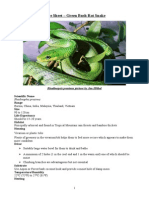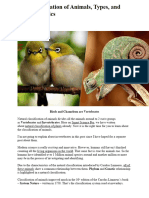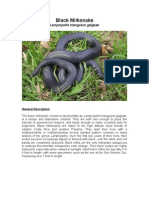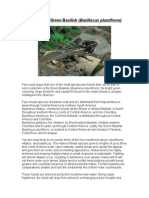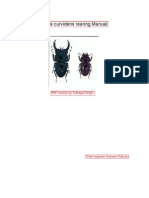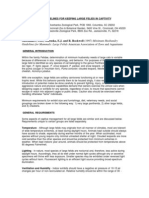0 ratings0% found this document useful (0 votes)
255 viewsCare Sheet - Garter & Ribbon Snakes
Care Sheet - Garter & Ribbon Snakes
Uploaded by
John GamesbyGarter and ribbon snakes require an escape-proof enclosure between 24-30 inches with a temperature gradient from 70F on the cool side to 84F on the basking side. They need a hide box, pool for swimming, climbing branches, and UVB lighting promotes their health and colors. These snakes eat a varied diet of earthworms, redworms, insects, fish, and mice and require fresh water daily while their enclosure needs periodic cleaning and disinfecting.
Copyright:
© All Rights Reserved
Available Formats
Download as DOC, PDF, TXT or read online from Scribd
Care Sheet - Garter & Ribbon Snakes
Care Sheet - Garter & Ribbon Snakes
Uploaded by
John Gamesby0 ratings0% found this document useful (0 votes)
255 views2 pagesGarter and ribbon snakes require an escape-proof enclosure between 24-30 inches with a temperature gradient from 70F on the cool side to 84F on the basking side. They need a hide box, pool for swimming, climbing branches, and UVB lighting promotes their health and colors. These snakes eat a varied diet of earthworms, redworms, insects, fish, and mice and require fresh water daily while their enclosure needs periodic cleaning and disinfecting.
Copyright
© © All Rights Reserved
Available Formats
DOC, PDF, TXT or read online from Scribd
Share this document
Did you find this document useful?
Is this content inappropriate?
Garter and ribbon snakes require an escape-proof enclosure between 24-30 inches with a temperature gradient from 70F on the cool side to 84F on the basking side. They need a hide box, pool for swimming, climbing branches, and UVB lighting promotes their health and colors. These snakes eat a varied diet of earthworms, redworms, insects, fish, and mice and require fresh water daily while their enclosure needs periodic cleaning and disinfecting.
Copyright:
© All Rights Reserved
Available Formats
Download as DOC, PDF, TXT or read online from Scribd
Download as doc, pdf, or txt
0 ratings0% found this document useful (0 votes)
255 views2 pagesCare Sheet - Garter & Ribbon Snakes
Care Sheet - Garter & Ribbon Snakes
Uploaded by
John GamesbyGarter and ribbon snakes require an escape-proof enclosure between 24-30 inches with a temperature gradient from 70F on the cool side to 84F on the basking side. They need a hide box, pool for swimming, climbing branches, and UVB lighting promotes their health and colors. These snakes eat a varied diet of earthworms, redworms, insects, fish, and mice and require fresh water daily while their enclosure needs periodic cleaning and disinfecting.
Copyright:
© All Rights Reserved
Available Formats
Download as DOC, PDF, TXT or read online from Scribd
Download as doc, pdf, or txt
You are on page 1of 2
Care Sheet - Garter & Ribbon Snakes
Coast Gartersnake (Thamnophis elegans terrestris) San Mateo County
Common Name: Garter, Ribbon, Water Snakes
Latin name: Thamnophis spp.
Native to: North and Central America
Size: Up to three feet in length
Life span: This group of snakes can live for 10 years or more with proper care.
General appearance: All members of the genus Thamnophis are slender-bodied
snakes and are usually striped with a solid or chequered body. Males generally
have a thicker base of the tail than females.
Housing requirements:
Enclosure: Most single snakes can be housed in a 24 vivarium or plastic pet
containers like the Fer-Plast or Exo Terra Faunariums. It is important that the
enclosure is escape-proof as these snakes excel at escaping from their
enclosures.
Temperature: Like most snakes, members of Thamnophis like a temperature
gradient. The cool end on the enclosure should be around 70 F with a basking
spot of around 84 F. At night the basking area should be turned off.
Heat/Light: It has not been proven whether these snakes require UV light or not,
though they should be provided with an appropriate photoperiod. Basking areas
can be achieved by using incandescent basking bulbs, infrared heat bulbs or
ceramic emitters. Timers and thermostats can be used to control photoperiods
and temperatures in the enclosure.
If the lighting is of the UVB type the colours and general health of the snakes is
better I have found personally.
Substrate: A variety of substrates can be utilized for these snakes. Newspaper
or paper towels can be used for young snakes then after a year use orchid bark
and moss.
Environment: A suitably large enough pool should be provided for the snake, to
allow it to swim. A hide box should also be provided. Branches for climbing can
also be provided.
Diet: These snakes eat a varied diet. Items such as earthworms, red worms, and
other insects will usually be readily accepted. Fish such as guppies, sand eels
and Lance fish can also be provided in the pool along with strips of trout. An
exclusive diet of just fish is not nutritionally complete and should be fed with other
prey items such as earthworms. Many specimens can also be converted to
appropriate sized mice, offer pinkie/fuzzy mice that have been rubbed with fish to
scent them.
Maintenance: Fresh water should be offered daily. If using newspaper then
clean as required. Wood shavings or a soil mix should be spot cleaned as
needed. Periodically, the enclosure should be disinfected. A 5% bleach solution
makes an excellent disinfectant. Be sure to rinse the enclosure thoroughly after
disinfecting. As always, be sure to wash your hands thoroughly after handling
your snake or any cage accessories.
Dusts the food in a vitamin supplement every other feed.
John Gamesby
You might also like
- BS 476Document1 pageBS 476Mohamed TahaNo ratings yet
- Care Sheet - African House Snake (Lamprophis)Document2 pagesCare Sheet - African House Snake (Lamprophis)John GamesbyNo ratings yet
- Care Sheet - Green Bush Rat SnakeDocument2 pagesCare Sheet - Green Bush Rat SnakeJohn GamesbyNo ratings yet
- Care Sheet - Diones Rat SnakeDocument2 pagesCare Sheet - Diones Rat SnakeJohn GamesbyNo ratings yet
- Care Sheet - Mangrove SnakeDocument4 pagesCare Sheet - Mangrove SnakeJohn GamesbyNo ratings yet
- Care Sheet - Fat Tailed GeckoDocument2 pagesCare Sheet - Fat Tailed GeckoJohn GamesbyNo ratings yet
- Tragopan 1314Document37 pagesTragopan 1314rkalsiNo ratings yet
- Wikijunior Big CatsDocument46 pagesWikijunior Big Catsfreebooks100% (5)
- Casquehead Iguana PDFDocument3 pagesCasquehead Iguana PDFJohn GamesbyNo ratings yet
- 5V From Portable Wind TurbineDocument7 pages5V From Portable Wind TurbineAl-hafiz JamilNo ratings yet
- Care Sheet - Corn SnakeDocument2 pagesCare Sheet - Corn SnakeJohn GamesbyNo ratings yet
- Classification of Living Thingsbiologygrade 9b Myp 4 4emesecond Term2023 20241713261495Document12 pagesClassification of Living Thingsbiologygrade 9b Myp 4 4emesecond Term2023 20241713261495decampostelma1No ratings yet
- Iguana: An Owner's Guide to a Happy Healthy PetFrom EverandIguana: An Owner's Guide to a Happy Healthy PetRating: 4 out of 5 stars4/5 (2)
- Care Sheet - Black Rat SnakeDocument2 pagesCare Sheet - Black Rat SnakeJohn GamesbyNo ratings yet
- Black Milksnake CaresheetDocument3 pagesBlack Milksnake CaresheetNathaniel GodinNo ratings yet
- Care Sheet - Common BoaDocument2 pagesCare Sheet - Common BoaJohn GamesbyNo ratings yet
- Untitled 2Document9 pagesUntitled 2api-343810234100% (1)
- ReptileHobbyst 1977/juneDocument116 pagesReptileHobbyst 1977/juneNickyu100% (2)
- Care Sheet - Great Plains Rat SnakeDocument2 pagesCare Sheet - Great Plains Rat SnakeJohn GamesbyNo ratings yet
- Care Sheet - Long-Nosed Snake (Rhinocheilus Lecontei)Document2 pagesCare Sheet - Long-Nosed Snake (Rhinocheilus Lecontei)John GamesbyNo ratings yet
- Care Sheet - Green BasiliskDocument5 pagesCare Sheet - Green BasiliskJohn GamesbyNo ratings yet
- Corn Snake Care SheetDocument14 pagesCorn Snake Care SheetlulavcNo ratings yet
- Red Tailed HawkDocument3 pagesRed Tailed HawkNilamdeen Mohamed ZamilNo ratings yet
- Snake Genetics 101Document3 pagesSnake Genetics 101api-239997483100% (1)
- Care Sheet - Flowered RacerDocument2 pagesCare Sheet - Flowered RacerJohn GamesbyNo ratings yet
- Be A Rid TrainingDocument8 pagesBe A Rid Trainingblazerman3No ratings yet
- Snake Pictures Types of Snakes (Non-Venomous) Scientific NameDocument4 pagesSnake Pictures Types of Snakes (Non-Venomous) Scientific NameLamborghini Cili BerapiNo ratings yet
- Reptiles - Snakes - Python Fact SheetDocument2 pagesReptiles - Snakes - Python Fact SheetUwaisNo ratings yet
- Tiger Barbs PDFDocument14 pagesTiger Barbs PDFamitdesai1508No ratings yet
- Care Sheet - Bull SnakeDocument3 pagesCare Sheet - Bull SnakeJohn GamesbyNo ratings yet
- Ookuwagata Rearing Manual (Stag Beetles Rearing Manual)Document25 pagesOokuwagata Rearing Manual (Stag Beetles Rearing Manual)Tathagat_No ratings yet
- Anatomy and Disorders Oral of Reptiles PDFDocument18 pagesAnatomy and Disorders Oral of Reptiles PDFGeovanni LunaNo ratings yet
- Great Horned Owl: North Carolina Wildlife ProfilesDocument3 pagesGreat Horned Owl: North Carolina Wildlife ProfilesprotoNo ratings yet
- Chapter 2 Snakes of Papua New GuineaDocument23 pagesChapter 2 Snakes of Papua New GuineaIrfan Haidar BasyirNo ratings yet
- 4th Mountain Lion Workshop.1991Document120 pages4th Mountain Lion Workshop.1991Lucía Soler100% (1)
- TigerDocument27 pagesTigerMsKarolyNo ratings yet
- Exotic Animals As PetsDocument7 pagesExotic Animals As PetsAndres VazquezNo ratings yet
- Zoo Guidelines For Keeping Large Felids in CaptivityDocument5 pagesZoo Guidelines For Keeping Large Felids in CaptivitySadaqat AliNo ratings yet
- Care Sheet - Carpet PythonDocument2 pagesCare Sheet - Carpet PythonJohn GamesbyNo ratings yet
- Ball PythonDocument1 pageBall PythonEric RoscoeNo ratings yet
- Dwarf Boas of The Caribbean PDFDocument5 pagesDwarf Boas of The Caribbean PDFJohn GamesbyNo ratings yet
- Handrearing GuideDocument8 pagesHandrearing GuideJohn Carlo LayugNo ratings yet
- The Common FrogDocument170 pagesThe Common FrogwilsonjoeNo ratings yet
- Leopard Gecko: Native Range MapDocument2 pagesLeopard Gecko: Native Range MapKang KemodNo ratings yet
- Indian Ringnecks. Indian Ringnecks pets. Indian Ringneck Owners Manual.From EverandIndian Ringnecks. Indian Ringnecks pets. Indian Ringneck Owners Manual.No ratings yet
- Care Sheet - Green IguanaDocument6 pagesCare Sheet - Green IguanaJohn GamesbyNo ratings yet
- How to Raise a Happy and Healthy Bearded Dragon: The Ultimate Guide to Reptile CareFrom EverandHow to Raise a Happy and Healthy Bearded Dragon: The Ultimate Guide to Reptile CareNo ratings yet
- Kingdom Animalia: Lita Puspa Dewi 1162060061Document11 pagesKingdom Animalia: Lita Puspa Dewi 1162060061Lita Puspa DewiNo ratings yet
- Poisonous SnakeDocument87 pagesPoisonous Snakeanggun fadilahNo ratings yet
- Animals World: By: Kathleen ChavezDocument60 pagesAnimals World: By: Kathleen ChavezMendez Justine KurtNo ratings yet
- Care Sheet - Amazon Tree Boa (Corallus Hortulanus)Document3 pagesCare Sheet - Amazon Tree Boa (Corallus Hortulanus)John GamesbyNo ratings yet
- The Pythons of New GuineaDocument16 pagesThe Pythons of New GuineaSofywka SofaNo ratings yet
- Plan and Animals in AustraliaDocument8 pagesPlan and Animals in AustraliaLeah & ZenithNo ratings yet
- HingebackTortoise PDFDocument4 pagesHingebackTortoise PDFJohn GamesbyNo ratings yet
- Saltwater Crocodile-Crocodiles Part IIIDocument21 pagesSaltwater Crocodile-Crocodiles Part IIIJohn GamesbyNo ratings yet
- Authors Metrics Comments Related ContentDocument15 pagesAuthors Metrics Comments Related ContentJohn GamesbyNo ratings yet
- Giant Snakes of Bygone Days PDFDocument11 pagesGiant Snakes of Bygone Days PDFJohn GamesbyNo ratings yet
- Morphological Correlates of Incipient Ar PDFDocument10 pagesMorphological Correlates of Incipient Ar PDFJohn GamesbyNo ratings yet
- Deep Intraspecific Divergences in The Me PDFDocument9 pagesDeep Intraspecific Divergences in The Me PDFJohn GamesbyNo ratings yet
- Calabar Python PDFDocument3 pagesCalabar Python PDFJohn GamesbyNo ratings yet
- Dwarf Boas of The Caribbean PDFDocument5 pagesDwarf Boas of The Caribbean PDFJohn GamesbyNo ratings yet
- An Introduction To Wolf SpidersDocument4 pagesAn Introduction To Wolf SpidersJohn GamesbyNo ratings yet
- A Paper On Cactaceae, Lobivia Ferox A New Record in Chilean FloraDocument8 pagesA Paper On Cactaceae, Lobivia Ferox A New Record in Chilean FloraJohn GamesbyNo ratings yet
- Flora of Peak Jabre, Paraíba, Brazilcactaceae - JussDocument6 pagesFlora of Peak Jabre, Paraíba, Brazilcactaceae - JussJohn GamesbyNo ratings yet
- Care Sheet - Pterinochilus MurinusDocument2 pagesCare Sheet - Pterinochilus MurinusJohn GamesbyNo ratings yet
- Care Sheet - Plated LizardsDocument3 pagesCare Sheet - Plated LizardsJohn GamesbyNo ratings yet
- Wilmar Villanoche Assignment 3 Abstract AlgebraDocument3 pagesWilmar Villanoche Assignment 3 Abstract AlgebraShaira LopezNo ratings yet
- Compactnostoc Shennongjiaensis Gen. y Especie Nov. (Nostocales, Cyanobacteria) de Una Roca Húmeda en ChinaDocument12 pagesCompactnostoc Shennongjiaensis Gen. y Especie Nov. (Nostocales, Cyanobacteria) de Una Roca Húmeda en ChinaElvis Ponce AbarcaNo ratings yet
- Hydraulic Case StudyDocument15 pagesHydraulic Case StudySiti Nurhaslinda Bt ZakariaNo ratings yet
- Benefits, Limitations, and Applications of The .STEP FileDocument4 pagesBenefits, Limitations, and Applications of The .STEP FilejackNo ratings yet
- Dynamic Depth FocussingDocument2 pagesDynamic Depth FocussingTHIRU.SNo ratings yet
- CY - GearDocument11 pagesCY - GearLoic DuigouNo ratings yet
- Fdocuments - in - The Traditional Architecture of Indonesiaby Barry Dawson John Gillow PDFDocument2 pagesFdocuments - in - The Traditional Architecture of Indonesiaby Barry Dawson John Gillow PDFDikson BaatNo ratings yet
- RPL Dfo 1-1 2-2 3-3 Rev 14Document32 pagesRPL Dfo 1-1 2-2 3-3 Rev 14Jesús Gabriel RodríguezNo ratings yet
- Nextivity Cel-Fi Plug & Play Signal BoostersDocument28 pagesNextivity Cel-Fi Plug & Play Signal BoostersjuharieNo ratings yet
- Expt 12-Stepper Motor Control Using 8051Document20 pagesExpt 12-Stepper Motor Control Using 8051nava krishnanNo ratings yet
- Eitz Chayim - Tree of Life (Draft)Document7 pagesEitz Chayim - Tree of Life (Draft)Laura Ruach JohnsonNo ratings yet
- Introduction To Operation SuiteDocument12 pagesIntroduction To Operation Suitekamalab04No ratings yet
- Trig, Ineq, StlinesDocument1 pageTrig, Ineq, StlinesAbburi KarthikNo ratings yet
- Polycoat RbeDocument2 pagesPolycoat RbeganmosesNo ratings yet
- HermesTRX Tetra MotorolaDocument2 pagesHermesTRX Tetra Motorolarikl0No ratings yet
- 0500 s19 in 11Document4 pages0500 s19 in 11sohamNo ratings yet
- Fiche Technique FT53027Document1 pageFiche Technique FT53027MateusNo ratings yet
- Green House Effect SeminarDocument26 pagesGreen House Effect SeminarShekhar Sharma82% (11)
- Biology ProjectDocument24 pagesBiology Projectprince gupta50% (2)
- Unit 3Document17 pagesUnit 3Ishani RoyNo ratings yet
- Get Curbside Consultation of the Shoulder 49 Clinical Questions First Edition Nicholson Md PDF ebook with Full Chapters NowDocument75 pagesGet Curbside Consultation of the Shoulder 49 Clinical Questions First Edition Nicholson Md PDF ebook with Full Chapters Nowerkeshkemgmo100% (6)
- TSE / TSR: Rod CombistatDocument2 pagesTSE / TSR: Rod CombistatQuiteNo ratings yet
- Good Laboratories Practice (GLP) in Pharmaceuticals - PharmaguidelineDocument2 pagesGood Laboratories Practice (GLP) in Pharmaceuticals - PharmaguidelineAhmed GasserNo ratings yet
- Example 4-Single Room With Ver-MohsinDocument7 pagesExample 4-Single Room With Ver-MohsinkhanclipcollectionNo ratings yet
- Sri Isopanisad Self StudyDocument16 pagesSri Isopanisad Self StudyKelisha Moodley100% (2)
- Blue Fire Light - PanelDocument5 pagesBlue Fire Light - PanelKevin GuerraNo ratings yet
- Visvesvaraya Technological University, BelagaviDocument27 pagesVisvesvaraya Technological University, BelagaviRachitha PrachithaNo ratings yet
- SOP Sewer Collection SystemsDocument14 pagesSOP Sewer Collection SystemsdexterNo ratings yet



